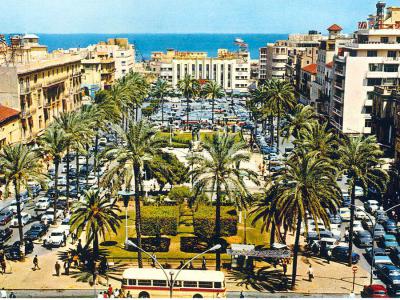Martyrs Square, Beirut
Today a popular spot for civil gathering and protests, Martyrs' Square in the heart of downtown Beirut is a famous landmark. The historic square took its name to commemorate the martyrs executed there. In 1916, on the orders of Djemal Pasha, Ottoman military ruler of Beirut, sixteen Lebanese men are marched into the ancient seaside square called Freedom Square. The men, Christians, Muslims, intellectuals, journalists and one poet are hung with minimal ceremony.
The square originally was an open area, near the ancient watchtower Burj al Kashef. It was a modern square in 1878. It had gardens, kiosks, fountains and souks. It became the main meeting place of the city.
The first Martyrs Monument was unveiled on 19 December 1930. The sculpture showed two women holding hands over a funeral urn. It was created by Youssef Hoyek, a local sculptor. Called "The Weeping Women", it proved unpopular and it was replaced in 1960 by the current Martyrs Monument of Italian sculptor Marino Mazzacuratti.
During the civil war of 1975-1990 the sqaure itself became the demarcation line dividing the city. In 2020 a devastating explosion in the harbor killed hundreds of people and flattened a large swath of the city. Within days there were demonstrations and riots.
People in general blamed government corruption and neglect. Once again Martyrs Square became the scene of blood and destruction. Many people had lost everything. The one thing that remains around Martyrs square is hope. The spirits of the Martyrs of 1916 still abide. There is always hope.
The square originally was an open area, near the ancient watchtower Burj al Kashef. It was a modern square in 1878. It had gardens, kiosks, fountains and souks. It became the main meeting place of the city.
The first Martyrs Monument was unveiled on 19 December 1930. The sculpture showed two women holding hands over a funeral urn. It was created by Youssef Hoyek, a local sculptor. Called "The Weeping Women", it proved unpopular and it was replaced in 1960 by the current Martyrs Monument of Italian sculptor Marino Mazzacuratti.
During the civil war of 1975-1990 the sqaure itself became the demarcation line dividing the city. In 2020 a devastating explosion in the harbor killed hundreds of people and flattened a large swath of the city. Within days there were demonstrations and riots.
People in general blamed government corruption and neglect. Once again Martyrs Square became the scene of blood and destruction. Many people had lost everything. The one thing that remains around Martyrs square is hope. The spirits of the Martyrs of 1916 still abide. There is always hope.
Want to visit this sight? Check out these Self-Guided Walking Tours in Beirut. Alternatively, you can download the mobile app "GPSmyCity: Walks in 1K+ Cities" from Apple App Store or Google Play Store. The app turns your mobile device to a personal tour guide and it works offline, so no data plan is needed when traveling abroad.
Martyrs Square on Map
Sight Name: Martyrs Square
Sight Location: Beirut, Lebanon (See walking tours in Beirut)
Sight Type: Attraction/Landmark
Guide(s) Containing This Sight:
Sight Location: Beirut, Lebanon (See walking tours in Beirut)
Sight Type: Attraction/Landmark
Guide(s) Containing This Sight:
Walking Tours in Beirut, Lebanon
Create Your Own Walk in Beirut
Creating your own self-guided walk in Beirut is easy and fun. Choose the city attractions that you want to see and a walk route map will be created just for you. You can even set your hotel as the start point of the walk.
Beirut Introduction Walking Tour
How many times can a city die? Beirut, in 5,000 years, has died and come back many times. Archeological digs downtown have revealed Phoenician, Greek, Roman, Byzantine, Arab, Crusader and Ottoman remains and signs of influence.
In 140 BC the city was destroyed by Diodotus Tryphon, a king of the Seleucid Empire. His Hellenistic city lies over the Phoenician one. Pompey the Great arrived in 64 BC... view more
Tour Duration: 2 Hour(s)
Travel Distance: 3.3 Km or 2.1 Miles
In 140 BC the city was destroyed by Diodotus Tryphon, a king of the Seleucid Empire. His Hellenistic city lies over the Phoenician one. Pompey the Great arrived in 64 BC... view more
Tour Duration: 2 Hour(s)
Travel Distance: 3.3 Km or 2.1 Miles
Seaside Walking Tour
If you wish to unwind or, perhaps, seek some quality time with your family and friends in a completely safe environment, while in Beirut, the local seaside area offers ample opportunities for both. Lined with palm trees, the city's waterfront guarantees a truly joyful experience and is as much fun for watching the Mediterranean, beautiful people and breathing the air as it is for exploring... view more
Tour Duration: 2 Hour(s)
Travel Distance: 3.2 Km or 2 Miles
Tour Duration: 2 Hour(s)
Travel Distance: 3.2 Km or 2 Miles





